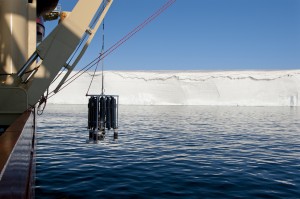The first science cruise of the ocean investigations of iSTAR took place on RVIB Nathaniel B. Palmer, an American ice-going research vessel, in collaboration with Prof. Stan Jacobs, Lamont-Doherty Earth Observatory, Columbia University. On cruise NBP10-05, from late November 2010 to mid-January 2011, we attempted to recover and subsequently redeploy some of the existing moorings in the Amundsen Sea – ideally close to Pine Island Glacier. Unfortunately the sea ice conditions were not kind, and we could not reach Pine Island Bay itself. However, we did manage to deploy two moorings, BSR12 and BSR13, near the shelf break in the westernmost trough leading down to Pine Island Bay.
The troughs crossing the shelf break are thought to be the main conduits of warmer Circumpolar Deep Water (CDW) onto the shelf and down to the surrounding ice shelves. Therefore we aim to place moorings in the main trough leading to Pine Island Bay, farther east, next season. In addition, we’ll place moorings farther south, closer to the ice shelf itself. These moorings will measure currents and temperatures, giving us more information about the processes bringing CDW down to the ice shelves.
The map below shows the NBP10-05 cruise track, and the location of our two moorings. The main project on NBP10-05, led by Dr. Patricia Yager from the University of Georgia, was investigating the large spring phytoplankton bloom, which takes place annually in the Amundsen Sea Polynya. You can read more about that work here.

